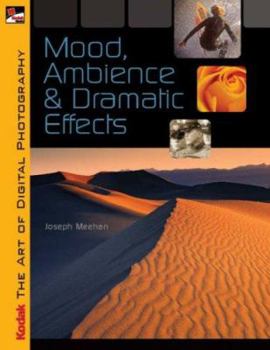Mood, Ambience & Dramatic Effects
Lighting, exposure, and computer effects: every one of these photographic elements helps create a photograph's ambience, transforming it from a simple document into an eloquent, interpretive piece of... This description may be from another edition of this product.
Format:Paperback
Language:English
ISBN:1579909701
ISBN13:9781579909703
Release Date:October 2007
Publisher:Lark Books (NC)
Length:191 Pages
Weight:1.73 lbs.
Dimensions:0.5" x 8.5" x 11.0"
Customer Reviews
1 rating
A Useful Guide
Published by Thriftbooks.com User , 16 years ago
Most serious photographers, after they learn the details of exposure and focus, begin to think about how to make something artful out of their pictures. They start to think about how they can manipulate the mood and ambience (the publisher's preferred spelling) of their images. From its title this book seems like an ideal tool to learn this phase of photography. The author starts out by discussing lighting, exposure, lens focal length, white balance, ISO, and filters. He moves on to long aspect ratios, weather conditions and infrared photography. The author's thesis is that great photographs require exceptional subjects and/or methods. I was pleased to see that in his discussion of lens focal length the author emphasized the use of lenses to control perspective (the relative sizes of foreground and background to subjects.) While this discussion avoided the often-heard misstatements about depth of field, Meehan labored long and hard to explain his point. I kept remembering the two pages of photos in "The Art of Outdoor Photography: Techniques for the Advanced Amateur and Professional" by Boyd Norton, with scarcely a written word that explained this same point so simply. 10 pictures were worth ten thousand words! The book is profusely illustrated with beautiful pictures that clearly demonstrate mood and ambience. Unfortunately, although the pictures were clearly tied to and indexed in the text, I wished we could have known more about their technical data and more importantly, the source of the vision to create them. Still the reader will benefit from studying these pictures closely and trying to understand how the author created the moods they convey. The book reads quickly and has plenty of white space. I wish it had been made a little more crowded by the author discussing composition. One of the problems is that it may be impossible to teach a person how to develop his or her vision so that the tools Meehan discusses can be applied to create a great picture. On the other hand I keep remembering books from the past that seemed to reach in this direction like Brenda Tharp's "Creative Nature and Outdoor Photography" and Freeman Patterson's "Photography and the Art of Seeing: A Visual Perception Workshop for Film and Digital Photography." Maybe I just don't have the soul of an artist but I can't always see how these tools will work to create that mood. Occasionally Meehan reached for that point, as in his discussion of white balance where he suggests that color casts can create mood and ambience, but I would have liked for him to explain what ambience was created by adding more red, and when I should use in-camera white balance, or when I should use Camera Raw adjustments or when I should use color balance or hue/saturation. I know that I'm asking a lot, and I'm not certain of the best way to convey this kind of information. I was impressed by Peter Watson's "Capturing the Light: An Inspirational and Instructional Guide to Landsca





